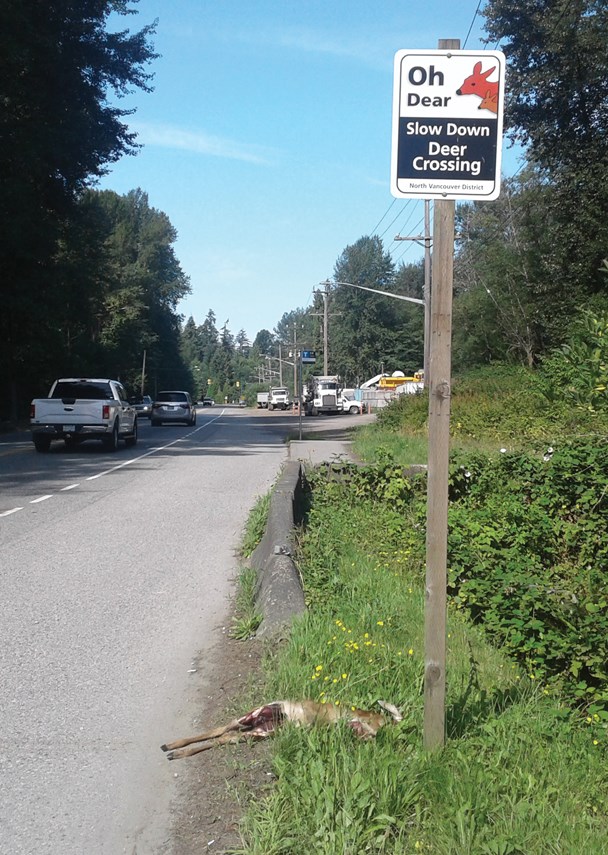The irony of a dead deer lying on the side of the road on the Dollarton Highway by a sign warning motorists: Oh, Dear, Slow Down, Deer Crossing, was deep.
Kevin Bell, a board member of Wild Bird Trust, received a phone call just before 9 a.m. on July 17 that a dead deer was on the side of the road in Maplewood.
It looked like the fawn had been hit on the road and then dragged to the side, Bell said.
As traffic gets busier and plans are being made to widen Dollarton Highway. Bell said the death of the deer is a warning that things could get worse – he fears one day a child will be hit and killed on the road.
According to Bell, the Wild Bird Trust is having discussions about wildlife corridors with Darwin Properties and Tsleil-Waututh Nation, who want to create the Innovation District in Maplewood.
“They say they’re committed to best practices but we really need to keep the pressure on them,” Bell said.
He would like McCartney Creek, a salmon-bearing water course that runs down the east side of the proposed Innovation District into the Maplewood Conservation Area, to be dedicated as a wildlife corridor that’s inaccessible to humans.
He also suggested, instead of building the Berkley Connector – a proposed extension of Berkley Road as a four-lane arterial route from Mount Seymour Parkway to Dollarton Highway – that it could be turned into a wildlife corridor as well.
The group is also researching the possibility of installing speed bumps, warning lights at night, motion sensors, a wildlife overpass and a culvert going under Dollarton.
In addition to deer, the conservation area is home to bobcats, coyotes, raccoons, and a wide variety of birds. Other wildlife, like black bears and cougars, make an appearance as well. There are even “very playful” river otters who will put a show on for visitors to the area, Bell explained.
“Usually, it’s mom hissing at you to let you know she’ll defend her young,” Bell said.
The area was well known for bird watching in the 1960s and ’70s. In 1982, Bell got involved in the Save Maplewood Flats Committee and 10 years later they were successful in making sure the area, owned partly by the Port Authority and partly by the District of North Vancouver, was protected as a conservation area.
Irwin Oostindie, president of Wild Bird Trust, said the main concern for the conservation group is to work with the district and the developer of the Innovation District to stop highway traffic from killing wildlife coming into the conservation area.
“With increasing development pressures, how can we introduce the best wildlife corridor planning and have it work in real life,” Oostindie said. “As we have seen with the District of North Vancouver road signage, encouraging drivers to watch for deer during morning rush hour is not working as drivers have no incentive to slow down.”
The organization recently decided to hire a researcher to look at long-term solutions to the conservation area and human stressors.



